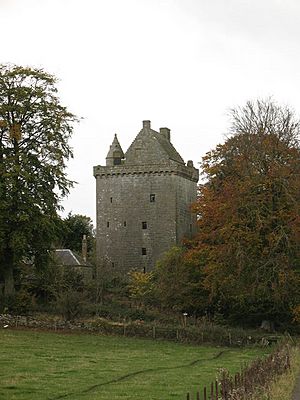John Scot, Lord Scotstarvit facts for kids
Sir John Scot, Lord Scotstarvit (1585–1670) was an important Scottish figure. He was a laird (a Scottish landowner), a lawyer, a judge, and a politician. He also wrote books. His job titles included Director of Chancery and Lord of Session. His last name is often spelled as Scott. The name of his home, Scotstarvit, can also be spelled Scotstarvet or Scotstarver.
Contents
Early Life and Career
John Scot was the only son of Robert Scot. His family had a long history in Scotland. His grandfather, also named Robert Scot, held an important government job called Director of Chancery. This office was in charge of creating and sending out official documents from the King.
John took over this important job in 1606 when he became an adult. This job was a big part of his life. He studied at St. Leonard's College in St. Andrews, starting around 1600. After college, he traveled abroad to study more. He became a lawyer in 1606.
In 1611, he bought land in Fife, which he named Scotstarvet. Six years later, King James VI made him a knight. He also became a privy councillor in 1622. This meant he was an advisor to the King. He even wrote a Latin poem for King James.
A Busy Public Servant
John Scot didn't work much as a lawyer. Instead, he found ways to help the King increase money for the country. In 1629, he became an extraordinary judge. By 1632, he was a full judge, known as Lord Scotstarvet.
He was one of many Scottish leaders who supported the Covenanters. This was a group who signed an agreement to protect their religion. He signed this agreement in 1638. In 1640, he helped on a committee to defend Scotland. He was reappointed as a judge in 1641. During the war between England and Scotland, he served on the war committee in 1648 and 1649. He also bought Inchkeith Island in 1649.
Challenges and Later Years
When Oliver Cromwell and the Commonwealth took power in England, John Scot lost his jobs as judge and Director of Chancery. He tried hard to get his Director of Chancery job back. He argued it was an administrative job, not a judicial one. But Cromwell gave the job to someone else.
Cromwell later fined John Scot £1,500 in 1654 for his part in the war. When the King returned to power, John Scot was fined again, this time £500. He did not get his old jobs back. Another person, Sir William Ker, got the Director of Chancery job. John Scot famously said Ker "danced him out of it."
A friend, Sir James Balfour, said John Scot was "a busy man in troubled times." Even with these difficulties, John Scot stayed active. He returned to Scotstarvet. There, he focused on writing and corresponding with other scholars. He passed away in 1670.
Contributions and Legacy
John Scot was known for being a bit unusual and sarcastic. He wrote a book called The Staggering State of Scottish Statesmen. It was published many years after his death. In this book, he shared his thoughts on politicians.
Scotstarvit Tower and Learning
Scotstarvit Tower, which Sir John rebuilt, is still standing today. You can see his initials and those of his first wife, Anne Drummond, carved above the door. The tower became a place for learning. John Scot invited many smart Scottish people to visit. He also exchanged letters with scholars from other countries, like Holland. His brother-in-law, William Drummond, wrote some of his famous works there.
In 1620, John Scot helped create a professorship for Latin studies at his old college, St. Leonard's. He also helped gather a large collection of classical books for the college library.
Mapping Scotland and More
John Scot was friends with Joan Blaeu, a famous mapmaker and publisher from Amsterdam. This friendship led to the creation of a special book of Scottish poems. John Scot paid for this book himself.
Even more importantly, John Scot helped publish detailed maps of Scotland. He was very interested in the maps started by Timothy Pont in 1608. After Pont died, John Scot made sure the drawings were updated by Sir Robert Gordon of Straloch and his son. In 1645, John Scot even went to Amsterdam to oversee the map publication. He helped write descriptions for many areas from his memory. The maps were finally published in 1654 as part of Blaeu's great atlas.
John Scot also showed his public spirit in other ways. He helped establish the Latin professorship at St. Andrews. He also set up a charity to help poor boys from Glasgow become apprentices.
His Family
John Scot was married three times. His first wife was Anne Drummond, who was the sister of the poet William Drummond. They had two sons and seven daughters. His second wife was Elizabeth Melville. His third wife was Margaret Monpenny. He had one son with each of his second and third wives. His son by his second wife, George Scott, became known for writing about America.
John Scot's direct male family line ended in 1776 with his great-great-grandson, also named John Scot. This later John Scot was very wealthy. His fortune mostly went to his eldest daughter. However, the Scotstarvet estate was sold to another family.


